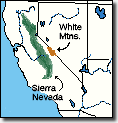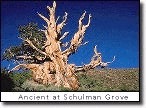|
Climatic changes

 During the years 1939-1953 Schulman's focus was on conifers in the lower forest zones, the habitat of the piñon and Douglas-fir. The longer records of the Giant Sequoia (Sequoiadendron giganteum) were not used because of the semi-humid region they grow in. Then he learned that certain species of trees in the upper-forest zones, growing under stressful conditions, showed sensitive records of drought in their growth-ring sequences, much more so than the rings of trees living in lower zones that can be unreliable due to ground water, etc. The short, distorted and dwarfed trees of the upper tree lines were now his focus. He discovered a Douglas-fir 600 yrs. old in Mesa Verde National Park, Colorado, an 800 year old bristlecone on Mt. Evans in Nevada, and a piñon pine of 975 yrs. in Utah. With all this data, a picture of the past climatic events began to emerge.
During the years 1939-1953 Schulman's focus was on conifers in the lower forest zones, the habitat of the piñon and Douglas-fir. The longer records of the Giant Sequoia (Sequoiadendron giganteum) were not used because of the semi-humid region they grow in. Then he learned that certain species of trees in the upper-forest zones, growing under stressful conditions, showed sensitive records of drought in their growth-ring sequences, much more so than the rings of trees living in lower zones that can be unreliable due to ground water, etc. The short, distorted and dwarfed trees of the upper tree lines were now his focus. He discovered a Douglas-fir 600 yrs. old in Mesa Verde National Park, Colorado, an 800 year old bristlecone on Mt. Evans in Nevada, and a piñon pine of 975 yrs. in Utah. With all this data, a picture of the past climatic events began to emerge.

 From 1215 to 1299 A.D. a severe drought took place and probably caused the Pueblo people to seek areas with adequate food, leaving their long-established homes. Following this calamity, the period (1300-1396) was shown to be one of extreme rainfall, probably a time
From 1215 to 1299 A.D. a severe drought took place and probably caused the Pueblo people to seek areas with adequate food, leaving their long-established homes. Following this calamity, the period (1300-1396) was shown to be one of extreme rainfall, probably a time
of great floods. Schulman began to see a 200 year cycle of flood and drought, and he formed a theory relating this cycle with sunspot phenomena that were observered to be in decline during this same period. But the hypothesis was put aside due to insufficient data.
|

 For eons the bristlecones (Pinus longaeva & aristata) have flourished
atop the arid mountains of the Great Basin, from Colorado to California, enduring extreme hardships and silently adjusting to their environment.
Their exquisite beauty was known to few. Their great age was known to none
For eons the bristlecones (Pinus longaeva & aristata) have flourished
atop the arid mountains of the Great Basin, from Colorado to California, enduring extreme hardships and silently adjusting to their environment.
Their exquisite beauty was known to few. Their great age was known to none the White Mountains acting on a rumor that old trees existed there.
Knowing such hearsay seldom proved to be true, the trip up the mountain was made anyway, and became fateful. Here they found a multiple-stemmed bristlecone fully 36 feet (10.9m) in circumference that had been named "Patriarch" by a local ranger. Although after taking samples, they found it to be only 1500 years old with typical ring growth of the upper tree line. But at this point they knew that the bristlecones were better recorders of drought conditions than the limber pines. Even more exciting were the old trees found nearby on even drier sites. The return home was filled with excitement for next year's field trip.
the White Mountains acting on a rumor that old trees existed there.
Knowing such hearsay seldom proved to be true, the trip up the mountain was made anyway, and became fateful. Here they found a multiple-stemmed bristlecone fully 36 feet (10.9m) in circumference that had been named "Patriarch" by a local ranger. Although after taking samples, they found it to be only 1500 years old with typical ring growth of the upper tree line. But at this point they knew that the bristlecones were better recorders of drought conditions than the limber pines. Even more exciting were the old trees found nearby on even drier sites. The return home was filled with excitement for next year's field trip.
 awed by these trees, often speaking with amazement about their ability to live so long with so little.
He wrote: "The capacity of these trees to live so fantastically long may, when we come to understand it fully, perhaps serve as a guidepost on the road
awed by these trees, often speaking with amazement about their ability to live so long with so little.
He wrote: "The capacity of these trees to live so fantastically long may, when we come to understand it fully, perhaps serve as a guidepost on the road





